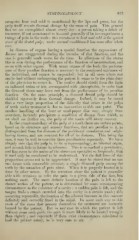Page 825 - My FlipBook
P. 825
SYMPTOMATOLOGY. 835
recognize heat and cold is contributed by the lips and gums, but the
pulp itself resents thermal change by the sense of pain. This general
fact we see exemplified almost every day : a person taking a drink of
ice-water, if not accustomed to it—and generally if he is—experiences a
twinge of pain in the teeth : this resentment to heat and cold is the special
sense of the dental 'pulp; under normcd conditions it has none other what-
ever.
In diseases of organs having a special function the expressions of
disease are exao-oerated durino; the exercise of that function, and the
case is generally made worse for the time. In affections of the uterus
this is seen during the performance of the function of menstruation, and
so on with other organs. With many organs of the body the perform-
ance of their peculiar function is necessary to the continued existence of
the individual, and cannot be suspended ; but in all cases where rest
can be had without endangering the patient it seems to be the plain duty
of the physician to secure it. The oculist should shield from the light
an inflamed retina or iris, accompanied witli photophobia, in order that
the diseased tissue may have rest from the performance of its peculiar
function. On the same principle, a diseased dental pnlp should be
shielded rigorously from thermal change. Indeed, it may be stated
that a very large proportion of the difficulty that arises in the pulps
of teeth under treatment is due to inattention to this one point. The
careless handling of the burr or sand-paper disc may, simply from
over-heat, instantly precipitate a condition of disease from which, as
we shall see farther on, the pulp of the tooth will never recover.
In the symptomatology of the pulp of a tootli there are certain points,
based on its structure and sensory functions, that are peculiar to it, as
distinguished from the diseases of the peridental membrane and neigh-
boring tissues, and are constant for all of its diseases. This being the
case, it may be well to consider these peculiarities separately. We have
already seen that the pulp is, in its symptomatology, an internal organ,
and as such fails to locate its ailments. This is so marked a peculiarity,
and has come to the notice of the observant specialist so frequently, that
it need only be mentioned to be understood. Yet the full force of this
proposition seems not to be appreciated. It may be stated that no one
can locate with reasonable certainty a single diseased pulp among the
teeth by the sensation of pain alone. When it is properly located it is
done by. other means. By the sensation alone the patient is generally
able with certainty to refer the pain to a given side of the face, but
nothing more. The more definite location of the pain is left to the
chance notion of the patient, or is determined by some accompanying
circumstance, as the existence of a cavity : a sudden pain is felt, and the
tongue finds a crumb crowded into the cavity in a certain tooth ; this
occurring repeatedly, the location of the ailment becomes in this manner
definitely and correctly fixed in the mind. In some such way as this
most of the cases that present themselves for treatment are correctly
located by the patient. But in any case in Avhich the patient is left
without some such guide the pain is more likely to be located Avrongly
than rightly ; and especially if there exist circumstances calculated to
lead the patient astray, he is very sure to err.


